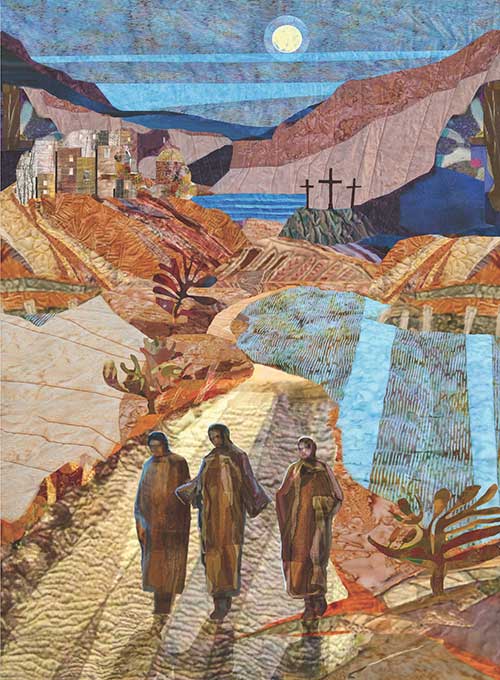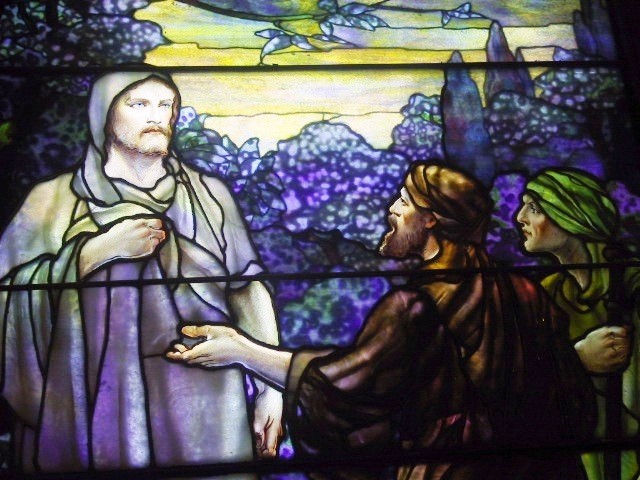
“Road to Emmaus” – Michael Torevell
Big Picture :
1) This is the third of the seven weeks of Eastertide, and the last of three stories of the risen Jesus appearing to his followers. The next four weeks (or three weeks, if Jesus’ Ascension is celebrated on the fourth) will explore Jesus’ teachings about faith and intimacy with God, all drawing on the Gospel of John.
2) As Luke tells it, this is the first time the risen Jesus steps onto the stage. In the passage just before this one, a group of women find Jesus’ tomb empty, and return to tell the male disciples that two angelic figures have proclaimed that he is alive — but the male disciples dismiss this as nonsense (though Peter, at least, goes to the tomb to see for himself). And now, in this week’s story, Jesus appears.
3) But not to Peter. Nor to Mary Magdalene. Nor to any of the others we’ve come to know over the course of the story. Moreover, Jesus doesn’t appear at the tomb, or at the Temple, or on the Mount of Olives, or at Herod’s palace or Pilate’s headquarters or the house of the high priest. Jesus’ post-crucifixion, alive-and-in-person appearance is, one would think, the highpoint of the story, the climax of the drama, the promised “rising again on the third day” — and so we would expect it to happen in some central, important place, to some central, important people in the narrative. But we’d be wrong. Where does Jesus appear? On a dusty road a couple of hours’ walk outside of Jerusalem, on the way to some now-forgotten village (archeologists today don’t know where “Emmaus” was located). And to whom? Two followers of Jesus — one named “Cleopas” and the other left anonymous — who haven’t even been mentioned yet in the story.
4) Come to think of it, this might remind us of where we began: the grand announcement of the Messiah’s birth is delivered to a few anonymous shepherds in the middle of nowhere (Luke 2:8-20). For Luke, the good news of the Gospel comes first of all not to insiders, but to ordinary folk in overlooked places. Just as he did when he was born, when Jesus rises and returns, he arrives from the outside in.
Scripture:
1) It’s Easter afternoon. In this story, the first surprise is that Jesus appears not in Jerusalem, but on a minor road to an obscure village. The second surprise is that he appears not to Peter, James, Mary, or Joanna, but rather to two minor characters in the story. But the third is the greatest surprise of all: though these two followers of Jesus originally staked their lives on the idea that he was the Messiah, “the one to redeem Israel” (literally “the one to set Israel free”); and though they’re heartbroken to have those hopes dashed; and though they’ve spent many months, perhaps years, walking with Jesus and listening to him along roads just like this one — still, they don’t recognize him (Luke 24:21). He’s right there, talking with them, walking beside them — and they don’t realize it’s him.
2) Why not? One possibility is that their eyes are veiled with tears; they’re overcome with sorrow about having seen their friend and teacher die, as well as disappointment that he turned out to be someone different than they’d hoped for. Perhaps their sadness and anxiety have turned them inward, away from the world, in oblivious self-absorption. They’ve lowered the window shades, we might say, from within their house of sorrow. Jesus is right there, standing outside — but they’re not looking.
3) Another possibility is that somehow Jesus is different, that resurrection doesn’t mean mere “resuscitation,” that the risen Jesus is in some way transformed. The two disciples lay eyes on him, hear his voice, even hear him teach — to no avail. From this point of view, the story suggests that the risen Jesus looks different, sounds different, even teaches in a different way. Cleopas calls him a “resident foreigner”: the word translated as “stranger” here is paroikeis, literally “reside as a foreigner” — suggesting that not only his apparent ignorance about current events (What are you talking about?) but also his overall appearance or style of speech comes across as an unfamiliar outsider (Luke 24:18).
Read more





